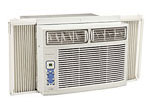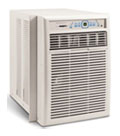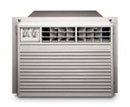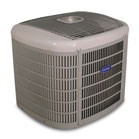| back to all buying guides |
| shop window air conditioners |
| shop wall air conditioners |
| shop a/c accessories |
Air conditioner buying guide: how to buy an air conditioner to fit your needs
 Some like it cold, some like it hot. For those who like it cold, air-conditioning is a life-saver. Credit can be given to Willis Carrier, American inventor who first introduced the air-conditioning machine in 1902. Today, millions of people enjoy the benefits of his invention.
Some like it cold, some like it hot. For those who like it cold, air-conditioning is a life-saver. Credit can be given to Willis Carrier, American inventor who first introduced the air-conditioning machine in 1902. Today, millions of people enjoy the benefits of his invention.
Throughout the years, air conditioners have advanced both in technology and style and now the selection to choose from is large and varied. So we’ve put together this informative guide to help you in the decision-making process.
To begin, use the following questions to help navigate through the key components of buying an air conditioner. Find in-depth information on the topics listed below by simply clicking on any of the following links:
- What are the different styles of air conditioners available?
- What sizes and electrical configurations do air conditioners come in?
- How powerful should an air conditioner be for any given space?
- What are some of the new and unique features available in air conditioners?
- How can an Energy Star air conditioner benefit me and the environment?
- How can I further protect the investment of my air conditioner?
What styles of air conditioners are available?
Air conditioners are offered in five unique and distinctive styles:
Window Air Conditioners:
 Window air conditioners are the most commonly used style in the industry. Designed primarily for use in a standard double hung window, they are constructed in various sizes and qualities. During installation, the air conditioner is mounted between the top of the open window and the sill below. Extendable louvers are used on each side to insulate the room from outside air.
Window air conditioners are the most commonly used style in the industry. Designed primarily for use in a standard double hung window, they are constructed in various sizes and qualities. During installation, the air conditioner is mounted between the top of the open window and the sill below. Extendable louvers are used on each side to insulate the room from outside air.
Not only are window air conditioners the most commonly used style, they are also the most affordable. In general, window units feature adjustable controls, making it easy to cool just one small bedroom or an entire floor with the same air conditioner. Depending on the floor layout, multiple units may be needed to distribute cold air evenly throughout a large space. One drawback to this style is that units must be removed from the window prior to winter and reinstalled each summer. Finally, window units exhaust moisture from the sides, and because of this, cannot be used in the wall.
Thru-The-Wall Air Conditioners:
 Wall air conditioners are designed specifically for use in a wall. They are unique in that air & moisture are ventilated exclusively through their back. This is an important point of difference from window air conditioners, which exhaust air and moisture out both the sides and the back. Please note: window air conditioners are NOT appropriate for use in a wall application, as the compressor may burn out from improper ventilation and moisture build-up could cause mold in the walls. Being somewhat of a specialty product, wall air conditioners are generally more expensive than window units.
Wall air conditioners are designed specifically for use in a wall. They are unique in that air & moisture are ventilated exclusively through their back. This is an important point of difference from window air conditioners, which exhaust air and moisture out both the sides and the back. Please note: window air conditioners are NOT appropriate for use in a wall application, as the compressor may burn out from improper ventilation and moisture build-up could cause mold in the walls. Being somewhat of a specialty product, wall air conditioners are generally more expensive than window units.
In both physical size and cooling power, wall air conditioners are bigger than window air conditioners. For installation, most wall units conform to standardized dimensions. A separate sleeve is also utilized inside the wall to protect from direct contact. If any gap exists within the existing sleeve it can often be filled with insulating foam strips.
Wall air conditioners are most commonly found in condominiums and apartments. Building managers and landlords often employ the same sleeve size throughout each unit to minimize the hassle associated with replacements. Homes with unusually sized windows incapable of supporting traditional window air conditioners or casement models typically use wall air conditioners instead.
Casement Air Conditioners:
 Casement air conditioners (also known as slider casement air conditioners) are very similar to window units, except that they are designed for use in framed windows with a sliding sash or metal casement. Casement air conditioners are tall and thin as opposed to traditional window units which are short and wide.
Casement air conditioners (also known as slider casement air conditioners) are very similar to window units, except that they are designed for use in framed windows with a sliding sash or metal casement. Casement air conditioners are tall and thin as opposed to traditional window units which are short and wide.
In general, casement air conditioners are more expensive than traditional window units and also available in a much smaller selection. Overall, the use of casement air conditioners is limited to room situations that rely solely on casement windows.
Slide-Out Chassis Air Conditioner:
Slide-out chassis isn’t as much of a style as it is an installation option for air conditioners. The term slide-out chassis technically means that the external housing and internal mechanics of the unit are separable. In most cases, the two components are separated during installation. The external housing is installed first, into a window or wall, and then the internal mechanics are installed into the housing.
 Slide-out chassis air conditioners tend to be very large units, typically sized at 15,000 BTUs or higher. The ability to separate is often a necessary component of installation as both the external housing and internal mechanics together can weigh up to 160 pounds!
Slide-out chassis air conditioners tend to be very large units, typically sized at 15,000 BTUs or higher. The ability to separate is often a necessary component of installation as both the external housing and internal mechanics together can weigh up to 160 pounds!
While ventilating through the sides & back, slide-out chassis units are technically window units. However, many slide-out chassis models can be installed into walls. The product documents will specify the maximum wall thickness. For example: if the maximum wall thickness of a unit is six inches, it means that the model may be installed into a wall, provided the wall is six inches deep or less. If the wall is thicker than the maximum wall thickness, it will block critical exhaust vents, impairing the air conditioner’s operation and lifespan.
Central Air Conditioner:
 Central air conditioners are installed outdoors and channel cold air into the house through duct work which is installed into the home. One of the advantages of a central air system is that it provides the quietest in-home environment due to its outdoor location. It also circulates indoor air through filters which can remove pollutants and enhance overall air quality.
Central air conditioners are installed outdoors and channel cold air into the house through duct work which is installed into the home. One of the advantages of a central air system is that it provides the quietest in-home environment due to its outdoor location. It also circulates indoor air through filters which can remove pollutants and enhance overall air quality.
Generally, central air conditioners are expensive to purchase and install. Due to the variance of heating systems in homes, the installation requirements for central air units can be challenging. Central air systems are a specialty appliance that can be provided upon request. For further information, speak to an appliance specialist about available options. return to top
What do I need to know about air conditioner sizes and electrical requirements?
 Window air conditioners range between 18″ and 26″ wide, and between 12″ and 18″ high. Extendable fins allow the air conditioner to be installed into windows sized between 36″ and 42″ wide. In contrast, casement air conditioners are approximately 20″ tall and 14″ wide with few exceptions.
Window air conditioners range between 18″ and 26″ wide, and between 12″ and 18″ high. Extendable fins allow the air conditioner to be installed into windows sized between 36″ and 42″ wide. In contrast, casement air conditioners are approximately 20″ tall and 14″ wide with few exceptions.
As a general rule, most wall air conditioners are 24 inches wide and 14 1/2″ high. GE wall air conditioners are an exception however, as they measure slightly taller and wider (26″ wide by 15 1/2″ high.) Wall air conditioners should fit snugly into the mounting sleeve with proper installation. Some manufacturers include insulating foam in their packaging – the air conditioner is sized slightly smaller than the existing sleeve this foam can be used to fill-in the missing space.
Electrical voltage requirements also vary. The following can be used as a general rule, but always check the specifications of the model you are looking at, prior to purchase.
Require 115 Volt:
- Window air conditioners up to 15,000 BTUs
- Wall air conditioners up to 10,000 BTUs
Require 208/230 Volt:
- Window air conditioners 18,000 BTU and higher
- Wall air conditioners 10,000-12,000 BTUs
It is also very important to verify that the voltage and size requirements of the new air-conditioner plug are met by the existing outlet. A qualified electrician can update the wiring and outlet configuration if required Amp usage should also be verified to prevent tripping a circuit breaker or fuse. return to top
How powerful should an air conditioner be for any given space?
The cooling capacity of an air-conditioner is measured in terms of BTUs or British Thermal Units. When determining what size air-conditioner is needed for a given space, a general rule of thumb is 20-30 BTUs are needed per square foot. For example, to cool a 400 square ft. room, an air conditioner between 8,000 and 12,000 BTU capacity is most appropriate.
When considering an air-conditioner for the kitchen, keep in mind that additional cooling power will be needed to offset the heat generated by cooking appliances. Furthermore, rooms or floors with sun exposure will receive more heat, and may require more cooling. As a general rule, air conditioners in a kitchen or room with lots of sun exposure require an additional 4,000 BTUs of cooling power.
If a large area such as an entire floor requires cooling, consider using two small air conditioners as opposed to one large unit. Cool air does not circulate as evenly as warm air. Because of this, one large air conditioner may over cool some parts of the room while leaving other parts under cooled. In a large space, separately installed air conditioners distribute cooling power more effectively.
In addition to cooling, air conditioners also dehumidify a small amount of moisture from the air. So it’s important to buy an air conditioner with cooling power appropriate to the size of the room it is in. If the air conditioner is too powerful, the room will be cooled too quickly for moisture to be removed. This results in a lower room temperature with high humidity levels. This kind of environment can cause the air conditioner to cycle on and off, ultimately creating a room that feels damp and clammy. return to top
What are some new and unique features available in air conditioners?
Air conditioners today come with an array of features designed to enhance energy efficiency and ease of use. Here are some unique features to look for when considering the purchase of a new air conditioner:
Mechanical controls
Mechanical controls feature a turning knob or switch to set the air conditioner to cool within a certain temperature range. The preset temperature settings are generally cool, cold and coldest.
Electronic controls
Electronic controls allow for the desired room temperature to be specifically set. The air conditioner then cools the room to that exact degree.
 Remote controls
Remote controls
Only available on models that feature electronic controls, the remote control feature allows the convenience of controlling the A/C settings from a distance. It can:
- Activate or deactivate the air conditioner
- Set a desired room temperature from a distance
- Activate a sensing mode which displays the temperature of a remote area in the room, versus the space closest to the A/C (depending on the model)
Adjustable Cooling Vents
 Adjustable vent controls help to circulate air. If a vent is left in the open position, the air conditioner will draw fresh, outside air into the room. If set to vent and exhaust, the air conditioner will exchange inside room air with fresh outdoor air. This feature is useful for removing pungent odors such as fish, garlic, or smoke from the room.
Adjustable vent controls help to circulate air. If a vent is left in the open position, the air conditioner will draw fresh, outside air into the room. If set to vent and exhaust, the air conditioner will exchange inside room air with fresh outdoor air. This feature is useful for removing pungent odors such as fish, garlic, or smoke from the room.
Adjustable Fan Speeds
Adjustable fans speeds feature multiple settings which can be set to personal preferences. Auto cool mode adjusts the fan speed automatically as room temperature changes. In the auto cool mode, cooler room temperatures slow the fan speed, while warmer room temperatures increase it.
Sleep Mode
Sleep mode can be programmed to gradually decrease the desired temperature over the course of several hours. This operation limits the amount of power used to cool, conserving energy. A delay start option allows the user to start or stop an air conditioner’s operation automatically at a later time.
LCDI (Leakage Current Detection & Interruption Device)
To enhance safety and prevent an electrical fire, many air conditioners include a Leakage Current Detection & Interruption Device, sometimes abbreviated to LCDI. The LCDI device monitors air conditioner power cord current flow and trips if damage to the cord is detected.
Quiet Operation
To maintain quiet operation, air conditioners use unique designs and engineering to help dampen sound. Sound blocking foam positioned around the air conditioner chassis helps to minimize cabinet vibration. Often, an air conditioner’s fan motor and compressor are mounted to the chassis with the use of sound-absorbing grommets. return to top
How can an energy efficient air conditioner benefit me and the environment?
 Engineered with small compressors and customizable programming options, today’s air conditioners use substantially more energy efficient than models dating back as few as eight years. In addition to electrical consumption, an air conditioner’s efficiency can be calculated by its EER or Energy Efficiency Rating (which is the BTU capacity divided by its running wattage). The higher the Energy Efficiency Rating is, the more efficient the air conditioner.
Engineered with small compressors and customizable programming options, today’s air conditioners use substantially more energy efficient than models dating back as few as eight years. In addition to electrical consumption, an air conditioner’s efficiency can be calculated by its EER or Energy Efficiency Rating (which is the BTU capacity divided by its running wattage). The higher the Energy Efficiency Rating is, the more efficient the air conditioner.
In order to meet Energy Star certification, an air conditioner must use 10% less energy than mandated government standards. In addition to putting more money in your pocket, updating an old air conditioner with an Energy Star model helps reduce the overall impact on the environment. In fact, if every air conditioner sold in the United States met Energy Star standards, it would prevent 1.3 billion pounds of greenhouse gas emissions, which is equivalent to the exhaust from 115,000 cars. return to top
How can I further protect the investment of my new air conditioner?
 Most manufacturers offer a one year limited warranty on their product. For as little as $50 Warners’ Stellian offers a Product Protection Guarantee designed to keep your new air conditioner operating as efficiently in the future as the day you purchased it. Our Product Protection Guarantee covers all functional parts and labor on your new appliance for up to two, three or five years. return to top
Most manufacturers offer a one year limited warranty on their product. For as little as $50 Warners’ Stellian offers a Product Protection Guarantee designed to keep your new air conditioner operating as efficiently in the future as the day you purchased it. Our Product Protection Guarantee covers all functional parts and labor on your new appliance for up to two, three or five years. return to top
We hope you have found this buying guide to be useful and informative and we appreciate the time you took to read through it. If you have questions that were not answered by this guide, please feel free to contact us.